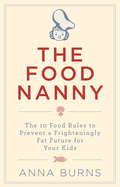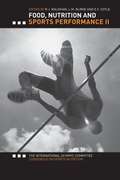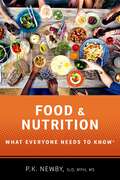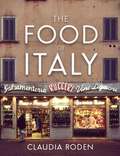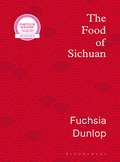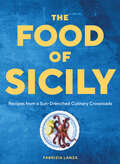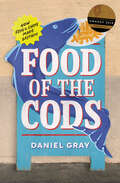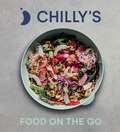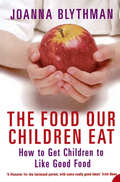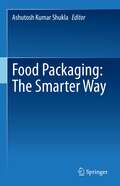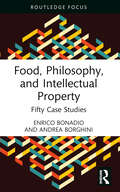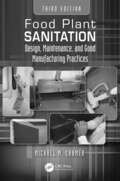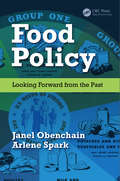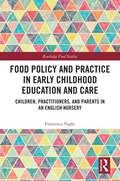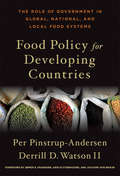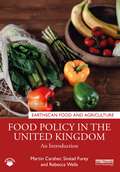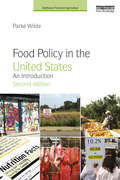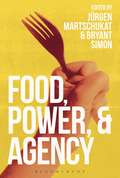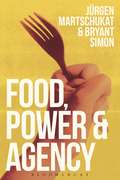- Table View
- List View
The Food Nanny: The 10 Food Rules to Prevent a Frighteningly Fat Future for Your Children
by Anna BurnsDo you find yourself constantly bombarded with requests for sweets, treats and snacks by your kids? Is the supermarket a battleground every time? Do your kids spend a lot more time indoors watching TV than you would have been allowed as a child? Would you love to see them eat more vegetables and make it through a movie without consuming the caloric allowance of a small elephant? If you want to do better for your kids, if you want to save them from a lifetime of yo-yo dieting, if you want them to be as Nature intended, The Food Nanny is here to help.
Food, Nutrition And Sports Performance II: The International Olympic Committee Consensus On Sports Nutrition (PDF)
by Ron Maughan L. M. Burke E. F. CoyleThis book summarizes the latest meeting of the world's leading researchers in sports nutrition, held at the IOC headquarters in Lausanne, Switzerland. The aim of the conference was to review the latest developments in the world of sport nutrition, to follow up on developments since the previous 1991 conference, and to draw up guidelines to help athletes and coaches optimise their performance by using nutrition to support training and maximise performance in competition. Subjects discussed in this cutting-edge collection include: * energy balance and body composition * the role of carbohydrates * the role of proteins and amino acids * athlete fluid and electrolyte requirements * the use of dietary supplements for optimum performance and immune function.
FOOD & NUTRITION WENK C: What Everyone Needs to Know® (What Everyone Needs To Know®)
by P.K. NewbyFrom gluten-free to all-Paleo, GMOs to grass-fed beef, our newsfeeds abound with nutrition advice. Whether sensational headlines from the latest study or anecdotes from celebrities and food bloggers, we're bombarded with "superfoods" and "best ever" diets promising to help us lose weight, fight disease, and live longer. At the same time, we live in an over-crowded food environment that makes it easy to eat, all the time. The result is an epidemic of chronic disease amidst a culture of nutrition confusion-and copious food choices that challenge everyday eaters just trying to get a healthy meal on the table. But the exhilarating truth is that scientists know an astounding amount about the power of food. A staggering 80% of chronic diseases are preventable through modifiable lifestyle changes, and diet is the single largest contributing factor. And we also know the secrets to eating sustainably to protect our planet. In Food & Nutrition, Harvard- and Columbia-trained nutrition scientist Dr. P.K. Newby examines 134 stand-alone questions addressing "need to know" topics, including how what we eat affects our health and environment, from farm to fork, and why, when it comes to diet, the whole is greater than the sum of its parts-and one size doesn't fit all. At the same time, Newby debunks popular myths and food folklore, encouraging readers to "learn, unlearn, and relearn" the fundamentals of nutrition at the heart of a health-giving diet. Her passion for all things food shines through it all, as does her love of the power of science, technology, and engineering to help create healthier diets for ourselves, and a more sustainable future for the planet we share.
The Food Of Italy
by Claudia RodenLike Elizabeth David, Claudia Roden can write about anything. Whether it's Middle Eastern, Spanish or Italian food, she is the cook to turn to. She is world renowned for her classic books like Arabesque and the Book of Jewish Food. These draw on her Egyptian Jewish roots so it's no wonder Middle Eastern chefs like Ottolenghi are among her biggest fans. But it is interesting to see that Russell Norman of Polpo cites Food of Italy as his favourite cookbook. Polpo is very cool, very modern, very Italian and yet still Claudia Roden's classic is his go-to cookbook. Food of Italy was first published 25 years ago next year. But the recipes are so fresh yet timeless they are hard to date. For this edition she has updated over 30% of the recipes to fit modern tastes with new inclusions like farro salad and burrata. The book is structured by region. So you get the glorious tomato and aubergine dishes of Sicily; the classically Roman dishes like salty meat and fried vegetables, and rich Tuscan stews and soups, and so on. With over 300 short recipes it is an incredible repertoire, and it is completely approachable for home cooks. This fully illustrated edition includes recipe photos as well as local Italy scenes. This is the first time it has had photos since it was originally published.
The Food of Sichuan
by Fuchsia Dunlop'No one explains the intricacies of Sichuan food like Fuchsia Dunlop. This book remains my bible for the subject' Jay RaynerA fully revised and updated edition of Fuchsia Dunlop's landmark book on Sichuan cookery.Almost twenty years after the publication of Sichuan Cookery, voted by the OFM as one of the greatest cookbooks of all time, Fuchsia Dunlop revisits the region where her own culinary journey began, adding more than 50 new recipes to the original repertoire and accompanying them with her incomparable knowledge of the dazzling tastes, textures and sensations of Sichuanese cookery.At home, guided by Fuchsia's clear instructions, you will be able to recreate Sichuanese classics such as Mapo tofu, Twice-cooked pork and Gong Bao chicken, or try your hand at a traditional spread of cold dishes comprising Bang bang chicken, Numbing-and-hot dried beef, Spiced cucumber salad and Green beans in ginger sauce. With spellbinding writing on the culinary and cultural history of Sichuan and accompanied by gorgeous travel and food photography, The Food of Sichuan is a captivating insight into one of the world's greatest cuisines.'This book offers an unmissable opportunity to utilise the wok and cleaver, brave the fiery Mapo tofu and expand your technique with pot-stickers and steamed buns' Yotam Ottolenghi
The Food of Sicily: Recipes from a Sun-Drenched Culinary Crossroads
by Fabrizia LanzaIn this all-new cookbook from Fabrizia Lanza, one of the world&’s greatest food cultures is distilled in 75 recipes for the home cook, plus a loving tribute to its ingredients, passions, influences, and history Tucked away on an estate in the countryside south of Palermo is the Anna Tasca Lanza Cooking School, a unique center dedicated to preserving and sharing the great food culture of Sicily. The spirit of the school, now run by Fabrizia Lanza, the founder&’s daughter and scion of a renowned family of winemakers that goes back generations, is what makes Lanza&’s The Food of Sicily such a singular cookbook—not just a collection of recipes and techniques, but a vibrant and beautifully photographed profile of the land, the people, the history, and so much more. On every page, in every recipe and note, the author captures the distinct taste of Sicily. How the simplest antipasti, brightly seasoned with nothing but lemon or vinegar, open the appetite—like a classic Octopus Salad or dish of Sautéed Black Olives. The little fried somethings—like an arancine or panelle—are easy, welcome, and nourishing. The Fresh Cavatelli, Pasta with Eggplant and Tomatoes, Bucatini with Sardines and Wild Fennel, and the eye-opening Anelletti Timballo explain why Sicilians are the biggest pasta eaters in the world. Festive meat dishes—such as Lamb-Stuffed Pastry, an Easter staple, or Grilled Sausage with Bay Leaves and Onions—are festive because the moment it&’s holiday time, Sicilians everywhere head outside and fire up their grills. And for a people known for their passion for sweets, some famous Sicilian treats—Watermelon Pudding, Lemon Granita, Rolled Fig Cookies, and the pinnacle of desserts, the elaborate Sicilian Cake with Ricotta Cream and Marzipan. Along the way, the author delves into everything from cheese, couscous, and olives to Amaro and the importance of bitterness. Visitors to Sicily often sense it to be a place unlike anywhere else—lost in time and a little bit secretive. The Food of Sicily opens a bright window on it, celebrating this wonderful food culture while honoring everything that makes it special.
Food of the Cods: How Fish and Chips Made Britain
by null Daniel GrayShortlisted for Debut Food Book of the Year at the Fortnum and Mason Food and Drink Awards 2024 ‘A lyrical, amiable and educational celebration of what may be our greatest achievement: the chippy.’ Stuart Maconie Step inside and unwrap this deliciously entertaining look at Britain’s national dish. There is a corner of every town and city in Britain where the air is tangy with vinegar and the scent of frying. Following the irresistible lure, Daniel Gray ponders the magic of chippies and the delights they have sprinkled among us for the last 150 years as he investigates the social – and sociable – history of fish and chips. Travelling to chippies from Dundee to Devon via South Shields, Oldham, Bradford, Bethnal Green, the Rhondda Valley and more – Daniel Gray explores our fish-and-chip nation to show how chippies have helped emancipate women, promote equality for immigrants and shape local and national identity. Whether you were raised eating scraps of Wolverhampton’s orange chips, London’s ‘wallies’ or Hull’s chip spice – even if you think you know whether tea, Vimto or dandelion and burdock is the best accompaniment – this mouth-watering book is as much about who we are as what we eat.
Food on the Go: The Chilly’s Cookbook
by Chilly'sIn Food on the Go you'll find healthy and tasty meals to suit all tastes, from sweet items such as Chia Seed Chocolate Powerpots and an On-The-Go Smoothie to fulfilling dishes including Easy Ramen, Lamb Curry Bao Buns, Bang Bang Tofu Salad and a Salmon Poke Bowl. Chapters include Breakfast, Soups & Hotpots, Wraps & Sandwiches, Salads, Snacks & Treats and Drinks, so Food on the Go will slot seamlessly into your lifestyle at any time of day.From the pioneers of reusables, these 75 easy and delicious recipes are designed to fit perfectly into your busy life - and your Chilly's products.Created to elevate your eating and drinking experience, Food on the Go is packed with convenient and exciting inspiration for every meal. Every recipe has been formulated to work dynamically with your Chilly's reusables, which will keep your food hot or cold throughout the day.
The Food Our Children Eat: How To Get Children To Like Good Food
by Joanna BlythmanA majority of British children mainly eat processed and junk food. Award-winning food writer Joanna Blythman takes a controversial look at this curious phenomenon and offers parents practical tips on how to improve their children’s diet.
Food Oxidants and Antioxidants: Chemical, Biological, and Functional Properties
by Grzegorz BartoszFood antioxidants are of primary importance for the preservation of food quality during processing and storage. However, the status of food depends on a balance of antioxidants and prooxidants occurring in food. Food Oxidants and Antioxidants: Chemical, Biological, and Functional Properties provides a single-volume reference on the effects of natur
Food Packaging: The Smarter Way
by Ashutosh Kumar ShuklaThis book reviews the science and technology of food packaging and covers the potential innovations in the food packaging sector. At the same time, it highlights the issues and prospects for linking the laboratory research to the market. In addition to typical packaging requirements such as food quality, shelf life, protection, communication, and marketing, the book emphasizes the need for novel packaging materials, including biodegradable packaging for a variety of food products. A wide range of food products has been kept in focus and includes animal-based food products such as dairy products and sea foods. The book presents the next level of packaging solutions i.e., smart packaging with the applications of potential tools such as intelligent and active packaging, and includes the latest research on emerging digital technologies for packaging development, assessment, and acceptability. It further highlights the strategies including blends, reinforcing agents, cold plasma, UV light applications, chemical, and enzymatic methods and explores the new opportunities leading to improvement in the packaging performance. Smart freshness indicator applications, including gas and time-temperature indicators for quality and safety of packaged products, have been covered in detail. The book also includes the functional characteristics of edible films and coatings, including their bioactive characteristics. Finally the book presents the rules and regulation related to packaging.
Food, Philosophy, and Intellectual Property: Fifty Case Studies
by Enrico Bonadio Andrea BorghiniThis is a book about food, philosophy, and intellectual property rights.Taken separately, these are three well-known subjects, but it is uncommon to consider them together. The book comprises 50 case studies, organized around eight themes: images; genericity and descriptiveness; language traps; procedures; menus, recipes, and creativity; boundaries; biotech; and empowerment. The introductory chapter frames the selection of cases and encourages readers to look beyond them, envisaging new lenses to look at food vis-à-vis intellectual property. The terrain encompassed is wide-ranging and reaches out to fine-grained aspects of food products, recipes, and cooking. Conceived for a wide scope of readers, the volume ultimately interrogates the links between food and cultural identity, bringing to the fore the ethical, political, and aesthetic worth of culinary arts and gastronomic experiences.This accessible book will be of value to scholars, students, practitioners, and others with interests in the areas of intellectual property, food law, and food studies.
Food, Philosophy, and Intellectual Property: Fifty Case Studies
by Enrico Bonadio Andrea BorghiniThis is a book about food, philosophy, and intellectual property rights.Taken separately, these are three well-known subjects, but it is uncommon to consider them together. The book comprises 50 case studies, organized around eight themes: images; genericity and descriptiveness; language traps; procedures; menus, recipes, and creativity; boundaries; biotech; and empowerment. The introductory chapter frames the selection of cases and encourages readers to look beyond them, envisaging new lenses to look at food vis-à-vis intellectual property. The terrain encompassed is wide-ranging and reaches out to fine-grained aspects of food products, recipes, and cooking. Conceived for a wide scope of readers, the volume ultimately interrogates the links between food and cultural identity, bringing to the fore the ethical, political, and aesthetic worth of culinary arts and gastronomic experiences.This accessible book will be of value to scholars, students, practitioners, and others with interests in the areas of intellectual property, food law, and food studies.
Food Plant Sanitation: Design, Maintenance, and Good Manufacturing Practices
by Michael M. CramerFood safety and quality are primary concerns in the food manufacturing industry. Written by an author with more than 40 years’ experience in the food industry, Food Plant Sanitation: Design, Maintenance, and Good Manufacturing Practices, Third Edition provides completely updated practical advice on all aspects of food plant sanitation and sanitation-related food safety issues. It offers readers the tools to establish a food safety system to help control microbiological, physical, and chemical hazards. Understanding that sanitation is integral to food safety is the foundation for an effective food safety system. Features of this new edition include new photographs, tables, and up-to-date material that better reflect current guidance on food plant sanitation, including additional information on the implementation of FSMA. The chapters address testing for and control of microorganisms in food manufacturing, including recent challenges in the industry due to pathogens such as Listeria monocytogenes. They also offer discussions on biofilms, regulatory requirements from the European Union, allergens, sanitary facility design, and describe proven best practices for sanitation as well as current sanitary requirements and regulatory changes from the FDA and USDA. In addition, the author presents methods for verifying sanitation, and provides greater differentiation of verification versus validation. The final chapters identify good manufacturing practices for employees and present a comprehensive pest management plan, including control measures and chemical interventions. The book concludes with strategies for preventing chemical and physical food safety hazards. This reference provides a practical perspective for implementing food plant sanitation and safety processes. The author has included, wherever possible, examples of procedures, forms, and documents to help novice food safety and quality professionals develop effective food safety systems.
Food Plant Sanitation: Design, Maintenance, and Good Manufacturing Practices
by Michael M. CramerFood safety and quality are primary concerns in the food manufacturing industry. Written by an author with more than 40 years’ experience in the food industry, Food Plant Sanitation: Design, Maintenance, and Good Manufacturing Practices, Third Edition provides completely updated practical advice on all aspects of food plant sanitation and sanitation-related food safety issues. It offers readers the tools to establish a food safety system to help control microbiological, physical, and chemical hazards. Understanding that sanitation is integral to food safety is the foundation for an effective food safety system. Features of this new edition include new photographs, tables, and up-to-date material that better reflect current guidance on food plant sanitation, including additional information on the implementation of FSMA. The chapters address testing for and control of microorganisms in food manufacturing, including recent challenges in the industry due to pathogens such as Listeria monocytogenes. They also offer discussions on biofilms, regulatory requirements from the European Union, allergens, sanitary facility design, and describe proven best practices for sanitation as well as current sanitary requirements and regulatory changes from the FDA and USDA. In addition, the author presents methods for verifying sanitation, and provides greater differentiation of verification versus validation. The final chapters identify good manufacturing practices for employees and present a comprehensive pest management plan, including control measures and chemical interventions. The book concludes with strategies for preventing chemical and physical food safety hazards. This reference provides a practical perspective for implementing food plant sanitation and safety processes. The author has included, wherever possible, examples of procedures, forms, and documents to help novice food safety and quality professionals develop effective food safety systems.
Food Policy: Looking Forward from the Past
by Janel Obenchain Arlene SparkAccess to safe, adequate, and nutritionally balanced food is a cornerstone of public health. Food Policy: Looking Forward from the Past examines the influences of grassroots movements, the government, and industry on the US food systems. The authors explore the intersection of food and nutrition and how policy influences this overlap. They illumina
Food Policy and Practice in Early Childhood Education and Care: Children, Practitioners, and Parents in an English Nursery (Routledge Food Studies)
by Francesca VaghiThis book is about food and feeding in early childhood education and care, offering an exploration of the intersection of children’s food, education, family intervention, and public health policies. The notion of ‘good’ food for children is often communicated as a matter of common sense by policymakers and public health authorities; yet the social, material, and practical aspects of feeding children are far from straightforward. Drawing on a detailed ethnographic study conducted in a London nursery and children’s centre, this book provides a close examination of the practices of childcare practitioners, children, and parents, asking how the universalism of policy and bureaucracy fits with the particularism of feeding and eating in the early years. Looking at the unintended consequences that emerged in the field, such as contradictory public health messaging and arbitrary policy interventions, the book reveals the harmful assumptions about disadvantaged groups that are perpetuated in policy discourse, and challenges the constructs of individual choice and responsibility as main determinants of health. Children’s food practices at the nursery are examined to explore the notion that, whilst for adults it is what children eat that often matters most, to children it is how they eat that is more important. This book contributes to a growing body of literature evidencing how children’s food is a contested domain, in which power relations are continuously negotiated. This raises questions not only on how children can be included in policy beyond a tokenistic involvement but also on what children’s well-being might mean beyond the biomedical sphere. The book will particularly appeal to students and scholars in food and health, food policy, childhood studies, and medical anthropology. Policymakers and non-governmental bodies working in the domains of children’s food and early years policies will also find this book of interest.
Food Policy and Practice in Early Childhood Education and Care: Children, Practitioners, and Parents in an English Nursery (Routledge Food Studies)
by Francesca VaghiThis book is about food and feeding in early childhood education and care, offering an exploration of the intersection of children’s food, education, family intervention, and public health policies. The notion of ‘good’ food for children is often communicated as a matter of common sense by policymakers and public health authorities; yet the social, material, and practical aspects of feeding children are far from straightforward. Drawing on a detailed ethnographic study conducted in a London nursery and children’s centre, this book provides a close examination of the practices of childcare practitioners, children, and parents, asking how the universalism of policy and bureaucracy fits with the particularism of feeding and eating in the early years. Looking at the unintended consequences that emerged in the field, such as contradictory public health messaging and arbitrary policy interventions, the book reveals the harmful assumptions about disadvantaged groups that are perpetuated in policy discourse, and challenges the constructs of individual choice and responsibility as main determinants of health. Children’s food practices at the nursery are examined to explore the notion that, whilst for adults it is what children eat that often matters most, to children it is how they eat that is more important. This book contributes to a growing body of literature evidencing how children’s food is a contested domain, in which power relations are continuously negotiated. This raises questions not only on how children can be included in policy beyond a tokenistic involvement but also on what children’s well-being might mean beyond the biomedical sphere. The book will particularly appeal to students and scholars in food and health, food policy, childhood studies, and medical anthropology. Policymakers and non-governmental bodies working in the domains of children’s food and early years policies will also find this book of interest.
Food Policy for Developing Countries: The Role of Government in Global, National, and Local Food Systems
by Per Pinstrup-Andersen Derrill D. Watson IIDespite technological advances in agriculture, nearly a billion people around the world still suffer from hunger and poor nutrition while a billion are overweight or obese. This imbalance highlights the need not only to focus on food production but also to implement successful food policies. In this new textbook intended to be used with the three volumes of Case Studies in Food Policy for Developing Countries (also from Cornell), the 2001 World Food Prize laureate Per Pinstrup-Andersen and his colleague Derrill D. Watson II analyze international food policies and discuss how such policies can and must address the many complex challenges that lie ahead in view of continued poverty, globalization, climate change, food price volatility, natural resource degradation, demographic and dietary transitions, and increasing interests in local and organic food production.Food Policy for Developing Countries offers a "social entrepreneurship" approach to food policy analysis. Calling on a wide variety of disciplines including economics, nutrition, sociology, anthropology, environmental science, medicine, and geography, the authors show how all elements in the food system function together.
Food Policy in the United Kingdom: An Introduction (Earthscan Food and Agriculture)
by Martin Caraher Sinéad Furey Rebecca WellsThis book provides an introduction to food policy in the United Kingdom, examining policy development, implementation, influences and current issues. The book begins by providing a wide-ranging introduction to food policy in the UK, situating it within wider global debates and establishing key drivers, such as issues related to global citizenship, trade and finance. The use of food control as a policy lever is also discussed and contrasted with alternative approaches based on behaviour change. The book presents an overview of the history of UK food policy, from which there is much to be learned, before moving onto current challenges posed by political instability, both at home and abroad, global pandemics and cost of living crises. Foremost is the need to manage public health, including both malnutrition and obesity, while promoting sustainable and healthy diets, as well as the broader issues around addressing food security and food poverty. The book also examines public sector food initiatives, such as school food and early childhood provisions, and food regulation. As a part of food regulation, chapters examine food scares and food fraud, from chalk in flour to "horsegate". The role of media, marketing and advertising is also considered within a policy perspective. Taking a wider lens, the book also discusses the impact of global food trade and the financialisation of food on food policy in the UK and vice versa. The book is supported by instructor eResources on the Routledge website designed to support student learning as well as provide regular updates on UK food policy developments. The eResources include student activities, group exercises and links to further reading and additional resources. This book serves as a key introduction to UK food and agricultural policy for students, scholars, policymakers and professionals, as well as those interested in food systems, public health and social policy more widely.
Food Policy in the United Kingdom: An Introduction (Earthscan Food and Agriculture)
by Martin Caraher Sinéad Furey Rebecca WellsThis book provides an introduction to food policy in the United Kingdom, examining policy development, implementation, influences and current issues. The book begins by providing a wide-ranging introduction to food policy in the UK, situating it within wider global debates and establishing key drivers, such as issues related to global citizenship, trade and finance. The use of food control as a policy lever is also discussed and contrasted with alternative approaches based on behaviour change. The book presents an overview of the history of UK food policy, from which there is much to be learned, before moving onto current challenges posed by political instability, both at home and abroad, global pandemics and cost of living crises. Foremost is the need to manage public health, including both malnutrition and obesity, while promoting sustainable and healthy diets, as well as the broader issues around addressing food security and food poverty. The book also examines public sector food initiatives, such as school food and early childhood provisions, and food regulation. As a part of food regulation, chapters examine food scares and food fraud, from chalk in flour to "horsegate". The role of media, marketing and advertising is also considered within a policy perspective. Taking a wider lens, the book also discusses the impact of global food trade and the financialisation of food on food policy in the UK and vice versa. The book is supported by instructor eResources on the Routledge website designed to support student learning as well as provide regular updates on UK food policy developments. The eResources include student activities, group exercises and links to further reading and additional resources. This book serves as a key introduction to UK food and agricultural policy for students, scholars, policymakers and professionals, as well as those interested in food systems, public health and social policy more widely.
Food Policy in the United States: An Introduction (Earthscan Food and Agriculture)
by Parke WildeThis new edition offers a timely update to the leading textbook dedicated to all aspects of U.S. food policy. The update accounts for experience with policy changes in the 2014 Farm Bill and prospects for the next Farm Bill, the publication of the 2015–2020 Dietary Guidelines for Americans, the removal of Generally Recognized as Safe (GRAS) status for trans fats, the collapse of the Trans Pacific Partnership (TPP) treaty, stalled child nutrition reauthorization legislation, reforms in food-labeling policy, the consequences of the 2016 presidential election and many other developments. The second edition offers greater attention both to food justice issues and to economic methods, including extensive economics appendices in a new online Companion Website. As with the first edition, real-world controversies and debates motivate the book’s attention to economic principles, policy analysis, nutrition science and contemporary data sources. The book assumes that the reader's concern is not just the economic interests of farmers and food producers but also includes nutrition, sustainable agriculture, food justice, the environment and food security. The goal is to make U.S. food policy more comprehensible to those inside and outside the agri-food sector whose interests and aspirations have been ignored. The chapters cover U.S. agriculture, food production and the environment, international agricultural trade, food and beverage manufacturing, food retail and restaurants, food safety, dietary guidance, food labeling, advertising and federal food assistance programs for the poor. The author is an agricultural economist with many years of experience in the nonprofit advocacy sector, the U.S. Department of Agriculture and as a professor at Tufts University. The author's blog on U.S. food policy provides a forum for discussion and debate of the issues set out in the book.
Food Policy in the United States: An Introduction (Earthscan Food and Agriculture)
by Parke WildeThis new edition offers a timely update to the leading textbook dedicated to all aspects of U.S. food policy. The update accounts for experience with policy changes in the 2014 Farm Bill and prospects for the next Farm Bill, the publication of the 2015–2020 Dietary Guidelines for Americans, the removal of Generally Recognized as Safe (GRAS) status for trans fats, the collapse of the Trans Pacific Partnership (TPP) treaty, stalled child nutrition reauthorization legislation, reforms in food-labeling policy, the consequences of the 2016 presidential election and many other developments. The second edition offers greater attention both to food justice issues and to economic methods, including extensive economics appendices in a new online Companion Website. As with the first edition, real-world controversies and debates motivate the book’s attention to economic principles, policy analysis, nutrition science and contemporary data sources. The book assumes that the reader's concern is not just the economic interests of farmers and food producers but also includes nutrition, sustainable agriculture, food justice, the environment and food security. The goal is to make U.S. food policy more comprehensible to those inside and outside the agri-food sector whose interests and aspirations have been ignored. The chapters cover U.S. agriculture, food production and the environment, international agricultural trade, food and beverage manufacturing, food retail and restaurants, food safety, dietary guidance, food labeling, advertising and federal food assistance programs for the poor. The author is an agricultural economist with many years of experience in the nonprofit advocacy sector, the U.S. Department of Agriculture and as a professor at Tufts University. The author's blog on U.S. food policy provides a forum for discussion and debate of the issues set out in the book.
Food, Power, and Agency
by Jürgen Martschukat Bryant SimonGrounded in the work of Roland Barthes, Bruno Latour, Pierre Bourdieu, and Michel Foucault, this exciting book uses food as a lens to examine agency and the political, economic, social, and cultural power which underlies every choice of food and every act of eating.The book is divided into three parts - National Characters; Anthropological Situations; Health – with each of the eight chapters exploring the power of food as well as the power relationships reflected and refracted through food. Featuring contributions from historians, sociologists, anthropologists, and cultural studies scholars from around the world, the book offers case studies of a diverse range -from German cuisine and ethnicity in San Francisco after the Gold Rush, through Italian cuisine in Japan, to 'ultragreasy bureks' and teenage fast food consumption in Slovenia.By directly engaging with questions of agency and power, the book pushes the field of food studies in new directions. An important read for students and researchers in food studies, food history, anthropology of food, and sociology of food.
Food, Power And Agency (PDF)
by Jürgen Martschukat Bryant SimonThis exciting book explores fundamental questions about the operation of power and agency in modern societies. Grounded in the work of Bruno Latour, Pierre Bourdieu, and Michel Foucault, it uses food as a lens to examine agency and the political, economic, social, and cultural power which underlies every choice of food and every act of eating. The book is divided into three parts - National Characters; Anthropological Situations; Health with each of the eight chapters exploring the power of food as well as the power relationships reflected and refracted through food. Featuring contributions from historians, sociologists, anthropologists, and cultural studies scholars from around the world, the book offers perspectives from a variety of disciplines and time periods. Case studies range from waiters in 20th century Europe and the United States, to German cuisine and ethnicity in San Francisco after the Gold Rush, Italian cuisine in Japan, and ultragreasy bureks and teenage fast food consumption in Slovenia. By directly engaging with questions of agency and power, the book pushes the field of food studies in new directions. An important read for students and researchers in food studies, food history, anthropology of food, and sociology of food.
